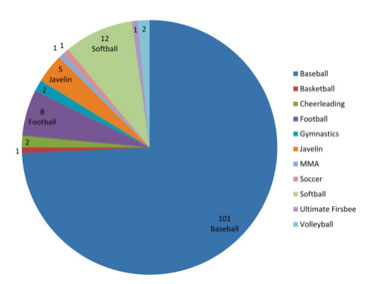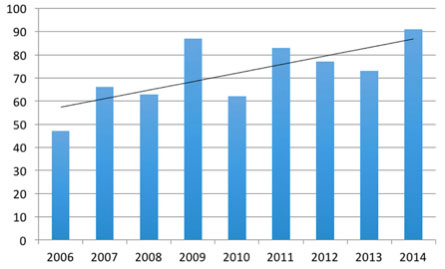
Boston Red Sox pitcher Chris Sale recently underwent a platelet rich plasma, or PRP, injection for a partial ulnar collateral ligament tear. The ulnar collateral ligament (UCL) is located on the inside of the elbow connecting the humerus (upper arm bond) and ulna (forearm bone). UCL injury results from repetitive stress on the elbow, and throwers who put extreme stress on the ligament are at highest risk. When the UCL tears, the elbow becomes unstable.
PRP injections can help athletes and individuals avoid surgery, and you do not have to travel to Florida and the Andrews clinic for this procedure. Learn more about UCL injuries and alternative to surgery.
How do UCL injuries occur?
The majority of UCL injuries occurring in overhead athletes. Throwing puts a tremendous amount of valgus torque on the elbow. While the UCL ligament is quite strong, the amount of forces placed across the elbow in overhead throwing athletes routinely exceeds the threshold for ligament failure (Labott et al 2018).
Not all UCL injuries occur in athletes, and UCL injuries can also occur from falls or trauma to the arm.
What are symptoms and causes of a UCL injury?
UCL injuries present with pain on the inside of the elbow. Typically, symptoms are more pronounced when athletes are throwing, and athletes will complain of a decrease in their throwing velocity and control.

UCL injuries by sport. Values represent the number of cases. MMA = mixed martial arts. Zaremski et al in Orthop J Sports Med, 2017
How are UCL injuries traditionally diagnosed and treated?
UCL injuries can sometimes be diagnosed through a history and physical examination, but the diagnosis is often confirmed with ultrasound or a MRI.
Treatment for UCL tears can range from rest and physical therapy to surgery, depending on the severity of the tear. In partial tears, initially non-surgical treatments are recommending, including rest, NSAIDs and physical therapy to strengthen the surrounding muscles and compensate for an injured UCL.

Number of UCL reconstructions per year from 2006 to 2014. Donohue et al in Sports Medicine Open, 2019.

Wins above replacement (WAR) for pitchers following ulnar collateral ligament reconstruction. Lansdown and Feeley, Orthop J Sports Med. 2014
What is Tommy John surgery?
Tommy John surgery repairs an injured ulnar collateral ligament. The surgery is named after former Los Angeles Dodgers pitcher Tommy John who underwent reconstruction of this ligament in 1974. At that time a torn UCL was considered a career ending injury.
In complete tears surgery is often recommended, and a tendon graft taken from somewhere else in the body or from a cadaver is used to reconstruct the ligament. While UCL injures that ultimate3ly require surgery are uncommon, the number of surgeries has been rising (Donohue et al 2019).
Part of the increasing frequency of surgery is that many players (28%) and coaches (20%) believe that the surgery can enhance performance beyond pre-injury level. The time to return to competition is also often underestimated with players (24%), coaches (20%) and parents (44%) (Ahmad et al 2012). While a high percentage of players will return to sport the rehabilitation can take one to two years, with the average time to full competition in one study of approximately 12 months (Cain et al 2010). In professional athletes, the average return to sport is almost 18 months.
What is the internal bracing procedure?
UCL reconstruction, or Tommy John surgery, has historically been the gold standard. Recently, there has been renewed interest in UCL repair with internal bracing using collagen-coated fiber tape and suture. Historically, UCL repair has had a high rate of failure. Unlike Tommy John surgery where the UCL is replaced, the repair involves suturing the collagen-coated fiber or tape directly to the UCL. The new repair may allow for a faster return to play, but still requires athletes to be in a brace for 6 weeks and avoid throwing for 18 to 20 weeks.
Can a UCL tears heal without surgery?
For partial tears, the literature on PRP is promising. Platelet rich plasma, or PRP, has been shown to be effective in treating partial ulnar collateral ligament (UCL) tears of the elbow. Podesta et al first reported a case series of partial UCL tears that responded to platelet rich plasma (PRP) injections with 88% of athletes returning to the previous level of play without complications and an average return to play of 12 weeks.
Dines et al of the Kerlan Jobe Orthopaedic Clinic in Los Angeles showed similar results with the average return to sport at 12 weeks, with better outcomes than earlier reported conservative treatments.
It is still unknown whether UCL has a role in complete UCL tears. Surgery is usually recommended, but a recent article article by Kato et al found PRP to be effective for both partial and complete tears.
Despite the promising results with PRP, a recent survey of the members of the American Shoulder and Elbow Surgeons showed only 36.3% of the surgeons offered PRP to treat UCL injuries (Hurwit et al 2017). In our clinic, we offer alternative solutions to UCL tears with the goal of stimulating a healing response, restore the integrity of the UCL and allow athletes to avoid surgery and enable them to return to play faster.
It is still unknown whether UCL has a role in complete UCL tears. Surgery is usually recommended, but a recent article
REFERENCES
Ahmad CS1, Grantham WJ, Greiwe RM. Public perceptions of Tommy John surgery. Phys Sportsmed. 2012 May;40(2):64-72.
Cain EL Jr, Andrews JR, Dugas JR, et al. Outcome of ulnar collateral ligament reconstruction of the elbow in 1281 athletes: Results in 743 athletes with minimum 2-year follow-up. Am J Sports Med. 2010 Dec;38(12):2426-34.
Dines JS, Williams PN1, ElAttrache N, et al. Platelet-Rich Plasma Can Be Used to Successfully Treat Elbow Ulnar Collateral Ligament Insufficiency in High-Level Throwers. Am J Orthop (Belle Mead NJ). 2016;45(5):296-300.
Donohue BF, Lubitz MG, Kremchek TE. Elbow Ulnar Collateral Ligament Reconstruction Using the Novel Docking Plus Technique in 324 Athletes. Sports Med Open. 2019;5(1):3.
Hurwit DJ. Garcia GH, Liu J, et al. Management of ulnar collateral ligament injury in throwing athletes: a survey of the American Shoulder and Elbow Surgeons. Journal of Shoulder and Elbow Surgery. 26(11):2023 – 2028.
Kato Y, Yamada S, Chavez J. Can platelet-rich plasma therapy save patients with ulnar collateral ligament tears from surgery? Regen Ther. 2019;10:123-126.
Labott JR, Aibinder WR, Dines JS, Camp CL.Understanding the medial ulnar collateral ligament of the elbow: Review of native ligament anatomy and function. World J Orthop. 2018;18;9(6):78-84.
Podesta L1, Crow SA, Volkmer D, et al. Treatment of partial ulnar collateral ligament tears in the elbow with platelet-rich plasma. Am J Sports Med. 2013;41(7):1689-94.
Lansdown DA, Feeley BT. The Effect of Ulnar Collateral Ligament Reconstruction on Pitch Velocity in Major League Baseball Pitchers. Orthop J Sports Med. 2014;2(2):2325967114522592.
Zaremski JL, McClelland J, Vincent HK, Horodyski M. Trends in Sports-Related Elbow Ulnar Collateral Ligament Injuries. Orthop J Sports Med. 2017;5(10):2325967117731296.
Adductor longus selective tenotomy is a modern surgical treatment for chronic groin pain that offers faster recovery and better outcomes than traditional full release surgery. The adductor longus, an inner thigh
Read MoreDiscover how ultrasound helps diagnose plantar fat pad atrophy, a leading cause of ball-of-foot pain. Learn about symptoms, thickness cutoffs, and why early detection matters for relief.
Read More